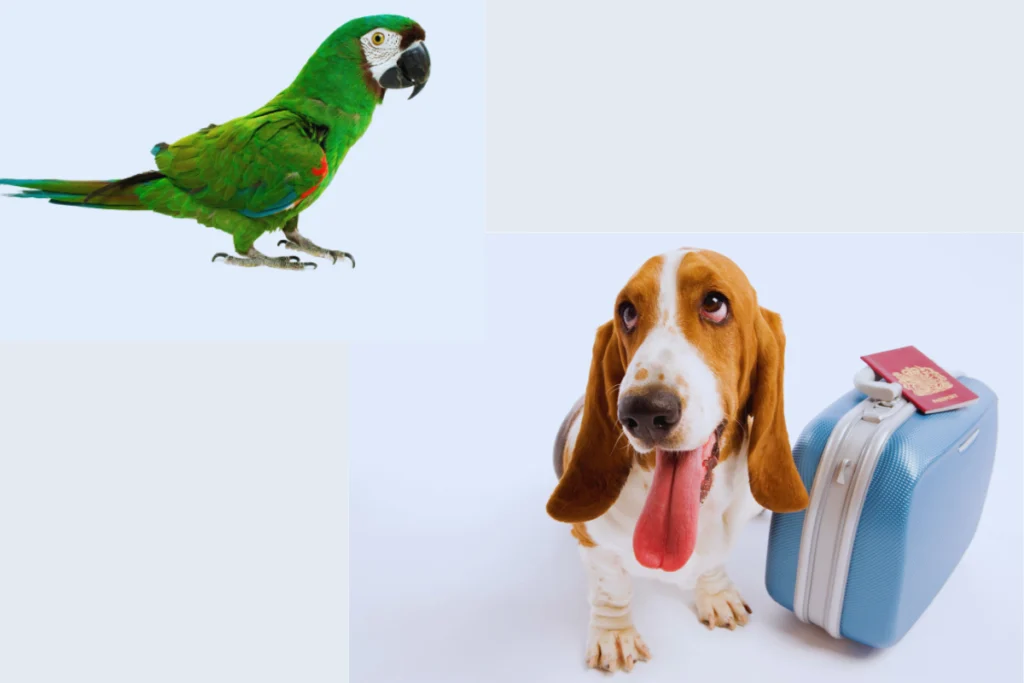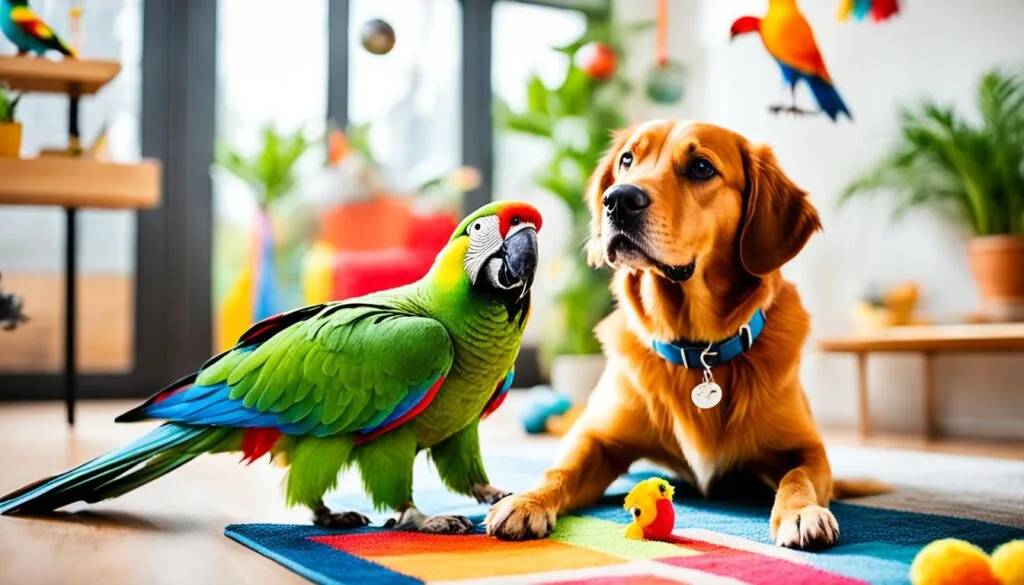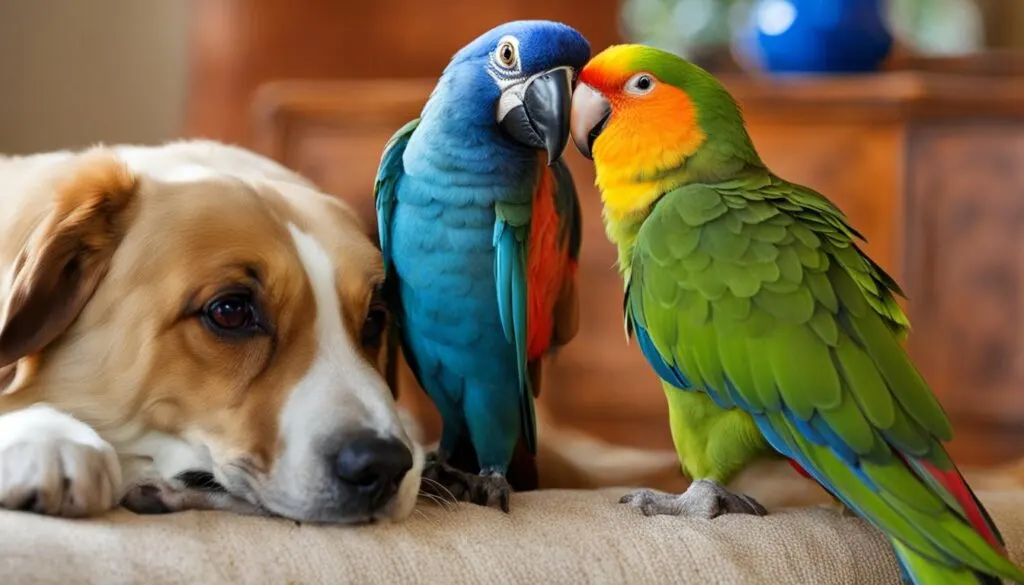Are you considering adding a parrot to your household, but concerned about how it will get along with your dog?
Believe it or not, compatibility between dogs and parrots is a common question among pet owners!
While each situation is unique, with proper understanding, introductions, and training, dogs and parrots can indeed live in harmony.
Click Here to Jump to a Section
Key Takeaways:
- Understanding the behavior and instincts of both dogs and parrots is crucial before introducing them.
- Proper introductions and gradual acclimation are essential to creating a positive environment for both pets.
- Training and socializing play a significant role in fostering a strong bond between dogs and parrots.
- Creating a suitable living space that accommodates the environmental needs of both pets is important.
- Supervision and safety measures must be in place to prevent any potential harm during their interactions.

With patience, consistency, and a commitment to providing a nurturing environment, you can build a strong friendship between your dog and parrot.
Let’s explore the factors that contribute to dogs and parrots living harmoniously and discover the steps you can take to ensure a successful coexistence between these two beloved pets.
Understanding Dog and Parrot Behavior
Before introducing a parrot to a household with a dog, it’s crucial to understand the behavior and instincts of both species.
Dogs and parrots have inherently different characteristics and responses, which can affect their ability to coexist harmoniously.
When it comes to dogs, they are known for their social nature and pack mentality.
They thrive on companionship and have a natural instinct to protect their territory.
Dogs often perceive their family members, including other pets, as part of their pack and may exhibit behaviors such as territorial marking, possessiveness, and dominance.
On the other hand, parrots are highly intelligent and social creatures.
They have a strong need for mental stimulation and frequent interaction with their human and avian companions.
Parrots bond closely with their flock members and can display territorial behaviors, especially when they feel threatened or insecure.
It’s important to note that every dog and parrot is unique, and their behavior can vary based on factors such as breed, individual temperament, early socialization, and previous experiences.
Understanding these differences is essential in determining if dogs and parrots can coexist peacefully in the same household.
Adaptability to Living Together
Dogs and parrots can develop relationships and even form strong bonds if introduced and managed appropriately.
Both species have the potential to adapt to each other’s presence, provided their individual needs are met and their interactions are supervised and controlled.
While dogs are generally more adaptable to new environments and companions, introducing them to a parrot requires careful attention.
Some dogs may show prey drive towards birds, making it challenging to ensure their safety around a parrot.
It’s important to consider the dog’s prey drive level, obedience, and ability to follow commands before introducing a parrot.
On the other hand, parrots should be socialized and trained to interact positively with dogs.
They should be familiarized with the dog’s smell, presence, and behaviors to reduce potential stress and fear responses.
Parrots can learn to coexist with dogs through gradual introductions and positive reinforcement training.
Understanding the behavior of dogs and parrots is the first step towards creating a harmonious living environment for both pets.
The next section will provide guidance on introducing dogs and parrots, ensuring a smooth and safe transition for everyone involved.
Introducing Dogs and Parrots
When bringing a new parrot into a household with a resident dog, proper introductions are crucial.
This step-by-step guide will help you create a positive and safe environment for both pets, promoting a harmonious coexistence.

1. Prepare the Environment
Before the introduction, prepare a separate area for your parrot where they can feel secure.
Consider using a cage or designated space that allows the parrot to observe the dog from a safe distance. This will help reduce initial stress and anxiety.
2. Separate Encounters
Begin by allowing the dog and the parrot to interact without direct physical contact.
Use baby gates, fences, or crates to create a physical barrier while they explore each other’s presence.
This gradual exposure allows them to become accustomed to each other’s scent and behavior.
3. Controlled Interactions
Once both pets are comfortable with each other’s presence, you can start supervised, controlled interactions.
Use leashes or harnesses to ensure safety and control during these initial meetings. Observe their body language closely to identify any signs of stress, fear, or aggression.
4. Positive Reinforcement
During the interactions, reward both pets with treats and praise for calm and appropriate behavior.
Positive reinforcement will reinforce their association with each other in a positive light.
Be patient and never force them to interact if they show signs of discomfort.
5. Gradual Progression
As they grow more comfortable with each other, gradually increase the duration and frequency of their interactions.
Allow them to approach each other without physical barriers, but always supervise closely.
Keep these sessions short initially and gradually increase their length over time.
6. Seek Professional Guidance
If you encounter any difficulties during the introduction process, consider consulting a professional dog trainer or an avian behaviorist.
These experts can provide guidance specific to your pets’ needs and help address any potential issues that may arise.
By following these guidelines and being attentive to their interactions, you can create a strong foundation for dogs and parrots to live together in harmony.
Remember, every pet is unique, and the introduction process may take time.
Be patient, consistent, and prioritize their safety and well-being above all else.
Training and Socializing
Training and socializing are vital aspects of ensuring a compatible and positive relationship between dogs and parrots.
With the right techniques and practices, you can help your pets develop a strong bond and understanding.
1. Positive Reinforcement Training
Positive reinforcement training is highly effective for both dogs and parrots.
Rewarding desirable behaviors with treats, praise, or playtime can encourage them to repeat those behaviors. Consistency and patience are key when teaching commands and tricks to your pets.
2. Socialization Opportunities
Allowing your dog and parrot to interact and socialize in a controlled environment is crucial.
This helps them get used to each other’s presence and promotes a sense of comfort and familiarity.
Start with short supervised sessions and gradually increase the duration.
3. Desensitization Techniques
Gradual exposure to specific situations or stimuli can help your dog and parrot become more comfortable around each other.
For example, you can introduce them to each other’s scents by swapping their bedding or toys. This can help reduce any initial fear or anxiety.
4. Separation Training
It’s important to train your pets to be comfortable while being separated.
This ensures their safety and prevents any potential conflicts or accidents.
Create separate areas for them with their own toys, food bowls, and resting spaces.
5. Supervised Interactions
Always supervise your dog and parrot when they are together.
This allows you to intervene if necessary and helps prevent any aggressive behaviors or accidents.
Gradually increase the duration of their interactions as they become more accustomed to each other.
Remember, every dog and parrot is unique, and it may take time for them to establish a harmonious relationship.
Be patient, provide plenty of positive reinforcement, and consult with a professional trainer or behaviorist for additional guidance.

Environmental Considerations
When it comes to dogs and parrots living together, it’s important to consider their differing environmental needs.
Creating a suitable living space that accommodates both pets’ requirements can promote a peaceful coexistence and strengthen their friendship.
Firstly, it’s crucial to provide separate areas for the dog and parrot.
Dogs need their own designated sleeping area, preferably in a quiet corner of the house, away from the parrot’s cage.
This gives the dog a sense of security and prevents any unnecessary stress or aggression.
For parrots, a spacious cage is essential.
Choose a cage size that allows the bird to fully stretch its wings and move around comfortably.
Provide perches and enrichment toys to keep the parrot mentally stimulated, as these birds are intelligent and require regular mental exercises to thrive.
Creating a peaceful environment includes minimizing potential triggers for both pets.
Keep the parrot’s cage away from high-traffic areas and loud noises, as excessive commotion can distress both the parrot and dog.
Additionally, provide the parrot with a consistent routine, including regular feeding times and exposure to natural light, which can contribute to their overall well-being.
Proper ventilation is vital in creating a healthy environment for both dogs and parrots.
Ensure there is adequate airflow in the living space to prevent the build-up of harmful fumes or bacteria.
Regular cleaning of cages, bedding, and surrounding areas is also essential to maintain cleanliness and reduce the risk of disease transmission.
Lastly, consider the temperature and humidity levels in the living space.
Dogs are more tolerant of varying temperatures compared to parrots, so it’s crucial to keep the room within the parrot’s comfort range.
Monitor the humidity levels, as excessively dry or damp conditions can negatively impact both pets’ health.
By taking these environmental considerations into account, you can create a harmonious living space that promotes the friendship between dogs and parrots.
Providing separate areas, maintaining cleanliness, and ensuring appropriate temperature and humidity levels contribute to the overall well-being of both pets and enhance their quality of life.
Supervision and Safety Measures
To ensure the safety of both dogs and parrots and facilitate a harmonious relationship between them, it is crucial to have proper supervision and safety measures in place during their interactions.
By implementing effective strategies, you can minimize potential risks and create a secure environment for both pets.
Here are some important guidelines to follow:
- Supervision: Always supervise dogs and parrots when they are together to prevent any unforeseen incidents or aggressive behavior. Be attentive to their body language and intervene if necessary.
- Separation: Keep dogs and parrots separated when unsupervised or during times when their interactions might become stressful. Provide separate living spaces to prevent any potential conflicts.
- Training: Ensure that both your dog and parrot are well-trained. Basic obedience commands such as “sit,” “stay,” and “leave it” are essential for maintaining control and redirecting their behavior when needed.
- Safe Zones: Create designated safe zones for your parrot, such as a cage or an elevated area out of reach of the dog. This allows the parrot to retreat and feel secure when necessary.
- Positive Reinforcement: Encourage positive interactions between dogs and parrots by rewarding them with treats, praise, and affection for good behavior. This reinforces their understanding of acceptable behavior and strengthens their bond.
- Environmental Considerations: Ensure that the environment is safe for both pets. Remove any toxic plants, secure electrical cords, and keep hazardous substances out of reach.
Remember, every dog and parrot relationship is unique, and it may take time for them to adjust and form a bond.
Patience, consistent training, and proper supervision are key to fostering a harmonious coexistence between dogs and parrots.
Building a Strong Dog and Parrot Relationship
Building a strong bond between dogs and parrots is essential for their compatibility and harmonious relationship.
While these two species have different communication styles and behaviors, with patience and appropriate training, they can become the best of friends.
One of the key factors in fostering a strong dog and parrot relationship is to engage them in activities that promote bonding.
For dogs, activities like going on walks, playing fetch, or participating in training sessions together can help build trust and a sense of companionship.
Parrots, on the other hand, enjoy interactive play sessions, puzzles, and training exercises that stimulate their cognitive abilities.
By involving both pets in these activities, you create opportunities for them to interact positively and establish a connection.
Enrichment is another crucial aspect of strengthening their friendship.
Providing toys, perches, and climbing structures that cater to the natural instincts and interests of both dogs and parrots can pique their curiosity and keep them engaged.
Rotate the toys frequently to maintain novelty and prevent boredom, which can lead to unwanted behaviors.
Lastly, positive reinforcement techniques are invaluable in building a strong dog and parrot relationship.
Rewarding both pets with praise, treats, and affection when they display desirable behaviors reinforces their understanding of what is expected from them.
Consistency and patience are key in this process, as it takes time for dogs and parrots to understand and respond to cues.
